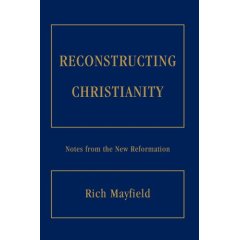December 10, 2007
The second Sunday in Advent had us worshiping with the saints at St. Gregory of Nyssa Episcopal Church in San Francisco. If you’re not familiar with this very different congregation, I’ll give you a brief description of our Sunday morning experience.
The facility is relatively new and very beautiful. Done in a style that is reminiscent of the wooden Russian Orthodox churches that were built along the northern California coast in the last couple of centuries, St. Gregory of Nyssa is located in a semi-industrial area of the city. It has the particular good fortune of being situated directly across from the Anchor Brewery, a source of great memories from my seminary days.
We were greeted at the door and asked to fill out nametags…red if you were a first-timer and black if you had visited before. The sanctuary is famous for its dramatic depiction of dancing saints that surround you as you enter the nave. It is a great collection of celestial celebrities that aren’t limited to just those of the Christian persuasion. There is even a dog dancing above your head…which is more than coincidental as I will soon reveal.
Luther is there and so is Gandhi and MLK Jr. and a host of others…go to their website for a neat illustration.
The nave is divided into two distinct parts. At one end are comfortable chairs divided into two sections that face each other. In the space between the chairs is a reading stand on one end, surrounded by a plethora of staffs that support all kinds of beautiful fabrics and designs. At the other end is a settee out of the movie “The Ten Commandments”. It is here that the preacher, seated, offers his homily. Next to the settee is a set of large bell bowls that are rung in sequence at appropriate times.
As we sat, waiting for worship to begin, several people made their way over to us to offer their welcome. Most welcoming, however, was a large mixed-breed dog whose owner laughingly told us that we were sitting in his pet’s favorite pew. Being dog people ourselves, the pup offered a wonderful introduction to our worship experience.
There were no musical instruments to be seen and, indeed, the worship was done entirely a capella. The service of the word moved at a meditative pace with some chanting of Psalms, a reading from Romans and a commentary from the preacher with reflections from the congregation as well. Periods of silence were particularly appreciated by me…although I must confess that this part of the worship experience was entirely too orthodox for me but, then, I’ve come to the conclusion that just about any Christian worship is too orthodox for me.
After a time of silence, we moved to the other half of the sanctuary where the table is placed. There are no chairs here and we entered singing and circling the table throughout the verses. We were then led into a rendition of the Lord’s Prayer with full body movement including prostrating ourselves on the sanctuary floor several different times. The Peace was shared with lots of hugs but respectful of visitors’ awkwardness in the midst of the congregation’s own intimacy. Beautiful prayers were offered and many of the congregants added their own petitions as well. There was a clear invitation to all to commune and while the bread was distributed by the celebrant, we offered the cup to each other.
Then we danced with the saints. Still in our circle, one of the priests instructed us as to the four step circle dance that we were about to employ. It was reasonably simple to follow and after a few faltering attempts, it was a delight to do. Such activity does tend to break down any inhibitions among the worshippers and served, as well, to help us experience the mural that was painted above us in a new and very existential way.
After the benediction, the worship table was stripped and quickly became the place for coffee and goodies. Such a transformation had the congregation remaining around the table for much longer than traditional worship allows.
No question that we will return to worship again…especially after the announcement that first-time visitors were expressly asked not to put anything in the offering basket but rather reflect on their experience in worship and, if they returned, to then give generously.
I seem to remember that this particular ministry was commenced by a priest who had significant financial resources of his own. In any case, such a style would certainly be dependent on a few very dedicated folk who were willing to support a congregation with a decidedly non-traditional worship that is anything but “contemporary”.
The current state of Christian worship, be it traditional or contemporary, rarely appeals to folk who are looking for theological integrity and intellectual challenge in their religious experience. The good folk at St. Gregory of Nyssa seem to be seeking to rectify that incongruity with an unusual approach that invites serious consideration for progressive Christians.
Monday, December 10, 2007
Subscribe to:
Post Comments (Atom)


No comments:
Post a Comment